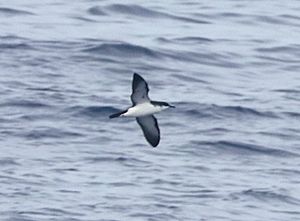Newell's shearwater facts for kids
Quick facts for kids Newell's shearwater |
|
|---|---|
 |
|
| Conservation status | |
| Scientific classification | |
| Genus: |
Puffinus
|
| Species: |
newelli
|
| Synonyms | |
|
Pufinus auricularis newelli |
|
The Newell's shearwater or Hawaiian shearwater (its Hawaiian name is ʻaʻo) is a special type of seabird. It's part of a group of birds called shearwaters. These birds can be tricky to tell apart! The Newell's shearwater lives only in the Hawaiian Islands. This means it is endemic to Hawaii.
Contents
What Does It Look Like?
The Newell's shearwater is a fairly small bird. It is about 33 centimetres (13 in) long. Its wings are about 223–249 millimetres (8.8–9.8 in) long. The bird usually weighs between 0.340–0.425 kilograms (0.75–0.94 lb).
Its back and top parts are black with a bit of brown. Its belly and underparts are white. The dark color on its face goes below its eye. This dark part is clearly separated from its white throat. It also has a white patch on its sides. This patch reaches onto the sides of its back.
The underside of its wings is mostly white. It has a dark edge. The feathers under its tail have a black and white pattern. They look white when the bird is flying. Its beak is dark grey or brown. Its legs and feet are mostly light pink.
This bird flies low over the water. It uses stiff wings. It mixes short glides with quick flapping. When it is near its breeding areas, it makes a loud call. It sounds a bit like a donkey braying.
Where Does It Live?
The Newell's shearwater makes its home in the Hawaiian Islands. It breeds in at least 20 different groups. These groups are found on mountain slopes. The biggest groups are on Kauaʻi. They live on slopes around the Alakaʻi Plateau. They probably also live in the Mokolea Mountains.
We are not sure about its exact locations on other islands. But we know it breeds on Molokaʻi. It also breeds on the island of Hawaiʻi. It might also breed on Oʻahu, Maui, and Lānaʻi.
From April to November, you can see these birds in the waters around Hawaii. They are especially common around Kauaʻi. When it's not breeding season, they fly far out into the tropical Pacific Ocean. We don't know much about where they go at sea. Many may travel south and east. They go into the waters of the Equatorial Counter Current. They have been seen as far west as the Mariana Islands. They have also been recorded in Samoa and American Samoa.
How It Behaves
Feeding Habits
This bird eats far from land. It prefers areas with very deep water, at least 2000 meters deep. We don't know much about what it eats. But its diet includes squid and small fish.
It dives into the water to catch its food. It can swim down to 10 meters deep. It uses its wings to move forward underwater. Newell's shearwaters are attracted to groups of tuna. They gather with other seabirds. They catch prey that the tuna drive to the surface.
Reproduction
By 1908, people thought this bird was extinct. But it was found again in 1947. In 1967, they found it breeding on Kauaʻi.
The nest is a burrow. It is dug into a steep slope. These burrows are usually hidden by uluhe ferns. The female lays one white egg. This usually happens in the first two weeks of June. Both parents take turns incubating the egg. The egg hatches after about 62 days.
The young birds leave the nest in October. This is 88 to 100 days after they hatch. They fly out to sea. After that, they no longer need their parents.
Why It Needs Our Help
The Newell's shearwater used to be much more common. It also bred in more places on the islands. But its numbers have gone down. This is because of habitat loss. It is also due to animals that were brought to the islands. These introduced species include mongooses, rats, cats, and barn owls. These animals hunt the birds.
Young birds are especially in danger. They are attracted to city lights at night. Many of them crash into power lines and buildings. In the mid-1990s, there were about 84,000 birds. But their numbers have dropped a lot recently. This might be because of Hurricane Iniki in 1992.
See also
 In Spanish: Pardela de Newell para niños
In Spanish: Pardela de Newell para niños


